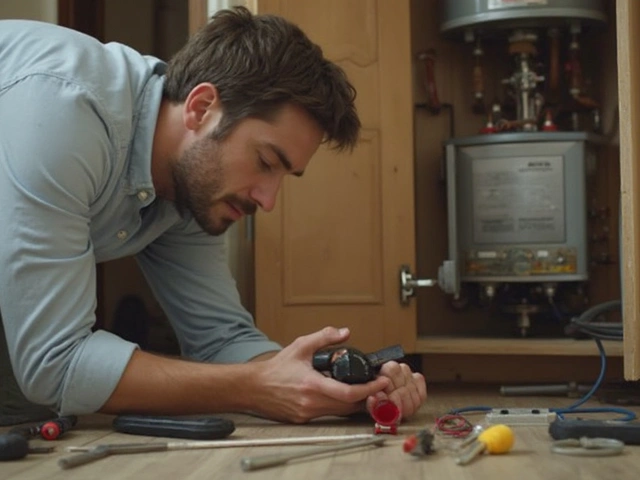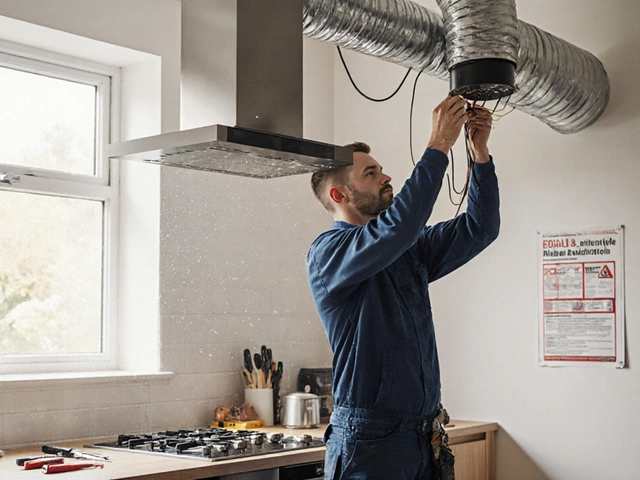So, your electric oven has turned into an extra pantry shelf. No glowing coil, no warm air, just raw dough and frustration. Before you start Googling new recipes for stovetop pizza, you probably want to know how much it’ll cost to get it cooking again.
First thing you need: Is it worth repairing? Sometimes it’s a tiny part, other times it’s something bigger that’ll cost as much as a new oven. Knowing what usually goes wrong can help you avoid overpaying for a simple fix—or stop you from dumping money into an oven with one foot in the grave.
The bad news: ovens are simple, but not all problems are cheap. The good news: just a couple of parts usually cause the “won’t heat” mistake, and most fixes don’t need a total appliance overhaul. A little know-how means you’ll spot a scam, haggle confidently, or even tackle a repair yourself if you’re handy.
Let’s cut through the confusion and get to the numbers, the common problems, and what you’ll actually pay in 2025 for a working oven—and skip the anxiety of feeling stuck or ripped off.
- Spotting the Problem: Why Your Oven Won’t Heat
- Price Guide: What Repair Pros Charge in 2025
- Parts Breakdown: What Fails and What It Costs
- Can You Fix It Yourself (and Should You)?
- Warranty, Age, and When to Buy a New Oven
- Getting Your Oven Back in Action: Next Steps
Spotting the Problem: Why Your Oven Won’t Heat
First, when an oven won’t heat, it’s usually one of a few usual suspects. Most of the time, it’s a busted heating element, a faulty temperature sensor, or an issue with the oven’s control board. Knowing where to look saves a ton of guesswork and prevents you from paying for a bunch of stuff you don’t need.
Here’s how these common problems show up:
- Electric oven repair is mostly about tracking down the one bad part, not rebuilding the whole thing.
- Broken bake or broil element: These are the glowing coils you see inside. If they burn out, you’ll see visible cracks or find they don’t glow red. If neither the bake nor broil works, it points to a bigger issue.
- Bad temperature sensor: If your oven gets a little warm but never reaches the set temperature, or the temp seems way off, this sensor might be causing it.
- Failed control board: If nothing at all heats, lights and buttons act weird, or settings won’t save, the main circuit board could be toast.
- Loose wires or tripped breaker: Sometimes it’s as simple as a loose connection or a circuit breaker that needs a flip.
Still stumped? Check out this quick cheat sheet of what’s likely wrong based on what you notice:
| What You Notice | Most Likely Problem |
|---|---|
| Oven lights up, but no heat | Heating element or temperature sensor |
| Neither bake nor broil works | Control board, wiring, or power issue |
| Oven heats, but way too slow | Weak element or sensor |
| Display or buttons flicker | Control board or loose wiring |
A quick test you can do is to set your oven to bake at 400°F and see if the lower element glows bright red. No glow? That’s almost always the element itself. If you want to get hands-on, you can check connections and make sure the breaker is on before calling in help. Just remember to unplug the oven before poking around—electricity and curiosity don’t mix well.
Price Guide: What Repair Pros Charge in 2025
Ready for some straight answers? Here’s what the average shop or appliance repair tech charges across the U.S. this year. Most people pay between $180 and $320 for an electric oven repair that fixes the “won’t heat up” problem. Of course, that’s the middle of the road. If your repair’s on the simpler side, like a blown fuse or a loose wire, expect a bill closer to $110-$160. But if you’re staring down a broken control board or a rare model, that number can tip up past $400—especially if you live where labor rates are steep.
The biggest factor is the part that needs fixing. Here’s what you’re usually paying for when the tech hands over the invoice:
- Service call fee: $75-$125 (covers diagnosis and first visit, even if nothing gets fixed right away)
- Labor: $60-$100 per hour, though a quick fix sometimes comes “bundled” into the service fee
- Parts: See the breakdown below—some run cheap, others are wallet-busters
To give you a real sense of repair math, take a look at this cost table. These are pulled from 2025 appliance repair company averages, not some random guesswork:
| Oven Problem | Typical Part Cost | Total Repair Cost (Parts+Labor) |
|---|---|---|
| Heating Element Replacment | $45-$85 | $140-$260 |
| Thermal Fuse | $10-$25 | $110-$170 |
| Oven Sensor | $30-$65 | $150-$230 |
| Control Board | $120-$280 | $260-$460 |
| Wiring / Short Circuit Fix | $8-$30 | $110-$170 |
If you’re in a big coastal city, bump those numbers up by 10-15%. If your oven is an ultra-modern smart model, add another $80-$120 for specialty parts or tricky diagnostics. Some places cut deals if you bring in your own part, or if you schedule repairs during slower weekdays.
Avoid surprises by shopping around: ask for a full estimate before any work starts, and watch out for “diagnostics only” service calls that don’t include the repair cost. If your oven’s over 10 years old and repairs hit the $400 mark, it might be time to think about a replacement instead. But for most folks, the fix lands squarely in the $150–$250 range and gets you back to baking without killing your weekend budget.
Parts Breakdown: What Fails and What It Costs
If your oven doesn’t heat, it’s almost always one of a handful of usual suspects. Knowing which part went bad helps you avoid wild repair bills and unnecessary parts swaps. Let’s run through them, what each one does, and what real costs look like for parts and labor in 2025.
- Heating Element: This coil (at the top for broil, bottom for bake) turns electricity into heat. It’s the most common reason an oven won’t heat. Replacement parts average $30-$70, and you’ll pay about $100-$180 total if a pro installs it.
- Thermal Fuse: It’s basically a safety kill switch. If your oven overheats, this fuse blows and the oven won’t heat at all till you replace it. Fuses run $10-$40, and repair costs add up to $90-$150 in total.
- Temperature Sensor: This sensor tells the control panel how hot your oven really is. If it’s faulty, your oven might not heat, or it runs cold. Sensors usually cost $20-$55 for the part. Expect $90-$160 for a technician install.
- Electronic Control Board: The brain of the oven. If it fails (sometimes after a power surge), the oven might not heat or could act up in weird ways. Control boards are pricey—just the part ranges $150-$350, and the full install is $250-$500, depending on the model.
- Igniter (for gas ovens, but some electric hybrids too): This glows hot to light the burner. A dead igniter means no heat. Replacement costs about $40-$90 for the part, $100-$220 installed.
To give a quick glance at what you might pay, here’s a table with the average price range for both the part and pro repair in 2025:
| Part | Part Cost | Total Cost with Labor |
|---|---|---|
| Heating Element | $30-$70 | $100-$180 |
| Thermal Fuse | $10-$40 | $90-$150 |
| Temperature Sensor | $20-$55 | $90-$160 |
| Control Board | $150-$350 | $250-$500 |
| Igniter | $40-$90 | $100-$220 |
Sometimes, problems overlap. My buddy called me last month after he replaced his heating element, only to find his control board was busted too. If you hear a click, but nothing gets hot, that usually means the control board, fuse, or sensor is to blame.
Pro tip: Always check your oven’s model number before buying any part. Parts can look identical but have totally different specs (and prices!).
If you’re still not sure which part is causing the headache, ask a reputable repair tech for a basic diagnostic (often around $70-$100). It’s a lot better than guessing and swapping $100 parts that don’t fix the problem.
When it comes to electric oven repair, sticking to what actually fails most often saves you money, time, and a whole lot of frustration.

Can You Fix It Yourself (and Should You)?
If your oven isn’t heating, you might be able to handle the fix yourself, but you have to know what you’re getting into. Don’t crack it open until you’re sure you’ve unplugged it—electric ovens pack a punch, and you really don’t want a shock. Most common problems boil down to a bad heating element, a busted thermostat, or a broken fuse. These are all possible for a careful DIYer with basic tools and a little patience.
Here’s what regular folks usually tackle:
- Heating element replacement: These burn out over time. Average price: $20–$70. It’s usually a couple screws and a couple of wires, just make sure you buy the right part for your model.
- Fuse replacement: Modern ovens have thermal fuses that blow to prevent fires. These cost $10–$50 and are accessible once you remove the back cover.
- Thermostat swap: If your oven runs but never gets hot, this could be the culprit. Expect to pay $30–$80 for parts, and a bit more patience for a fiddly job.
What about the harder stuff? Messing with the control board or fixing wiring issues can get tricky fast. That’s when it pays to call a repair tech—they’ve got meters and know-how, so you don’t risk frying the board or even yourself.
Curious how folks fare with DIY repairs? One home appliance study from late 2024 showed that about 35% of people attempted an electric oven fix at home. Of those, roughly two-thirds reported success when the fault was with a simple part (like the element or fuse), while less than 20% nailed it if the issue was electronic.
| Part | DIY Success Rate | Typical Cost |
|---|---|---|
| Heating Element | 75% | $20–$70 |
| Thermal Fuse | 60% | $10–$50 |
| Thermostat | 55% | $30–$80 |
| Control Board | 15% | $100–$300 |
So, should you do it yourself? If you’re swapping a heating element or fuse on a modern oven, give it a go. Watch a couple of YouTube videos for your exact model. If your issue is with the control board or you’re unsure where to start, get a pro—especially if your oven’s still under warranty. Remember: the real savings come when you know your limits and avoid turning a $50 problem into a $500 one.
Pro tip: Take a photo of your wiring before you swap parts. Trust me, trying to remember where every wire goes after “just winging it” is a headache you don’t want.
And one more thing—if you ever smell burning plastic or see visible sparks, stop. Unplug the oven and call a tech. That’s a sign of a bigger, riskier problem.
Warranty, Age, and When to Buy a New Oven
Before you hand over cash for a repair, check if your oven is still under warranty. Most new electric ovens come with a manufacturer’s warranty—usually covering parts and labor for one year. Some brands, like Whirlpool or GE, offer up to five years on certain parts like the heating elements. If your oven is less than a year old and not heating, call the company before doing anything. They’ll usually send a tech for free.
But what if your oven is older? Here’s where the math starts to matter. The average lifespan of an electric oven is right around 13 to 15 years. If yours is past year ten, you’re getting close to the point where big repairs don’t pay off. Dropping $300 or $400 on repairs for an oven that’s already a decade old is kind of like paying for a major engine repair on a really old car—sometimes it’s better to start fresh.
A lot of folks wonder: is there a rule for when to fix or replace? Appliance pros often use the 50% rule:
- If the oven repair will cost more than half the price of a new one, just replace it.
- If it’s a simple fix under 50% of the price of a new oven, go ahead and repair.
New standard electric ovens (not ranges) average between $400 and $800 in the US, as of 2025. If you have a built-in or fancy smart oven, prices jump pretty fast—think $1500 or more.
Here’s a breakdown in a no-nonsense table:
| Oven Age | Typical Repair Worth It? | Notes |
|---|---|---|
| < 5 years | Usually Yes | Often covered by warranty, parts newer |
| 5–10 years | Maybe | Depends on repair cost vs. new price |
| 10+ years | Rarely | Risk of more breakdowns soon |
One more thing: if your oven is totally outdated (those old dial models from the early 2000s) and the fix isn’t a cheap one, you’re almost always better off buying a new one. Newer models are more energy-efficient and have better safety features too.
So, before you call a electric oven repair guy, grab your oven’s serial number, check your paperwork, and look at the math. If it’s old, not under warranty, and the bill makes you wince, it’s probably time to retire the relic and start checking out new ovens online.
Getting Your Oven Back in Action: Next Steps
If you’re tired of reheating leftovers in the microwave, here’s how to actually get your oven back up and running. Whether you’re calling the pros or grabbing a screwdriver yourself, these steps will help you get the job done right—without dropping cash for nothing.
- Check the basics first. Double-check the power (is it plugged in? is the breaker flipped?), and make sure it’s not something silly like the timer or child lock still on. You’d be surprised how often the main issue is right in front of you.
- Have you already done a quick visual check? Look for signs like broken heating elements, loose wires, or error codes on the display. A blown element is usually easy to spot—sometimes it’s even visibly burnt or broken.
- If the oven is under warranty, don’t try to fix it yourself—call the manufacturer or retailer for a service visit. Most standard oven warranties last one year, but some brands offer up to five for parts.
If you need a repair tech, get estimates from at least two companies. Ask for the cost of both labor and parts. As of 2025, the average upfront service call is about $95, which typically covers the diagnosis. The actual repair, if you go ahead, ranges from $120 to $430 depending on what’s busted.
| Common Problem | Average Repair Cost (2025, USD) |
|---|---|
| Bake Element Replacement | $160 |
| Thermostat/Temperature Sensor | $180 |
| Control Board | $315 |
| Wiring/Electrical Issues | $200 |
For folks handy with tools, replacing a bake element is usually doable in under 30 minutes. Just remember: always unplug the oven or cut its power at the breaker box before you go poking around. Safety first—nobody wants a shocking baking experience.
The electric oven repair world isn’t as mysterious as it may seem. If you take it one step at a time, do your homework, and don’t panic, you’ll be back to roasted veggies and crispy cookies faster than you think.







